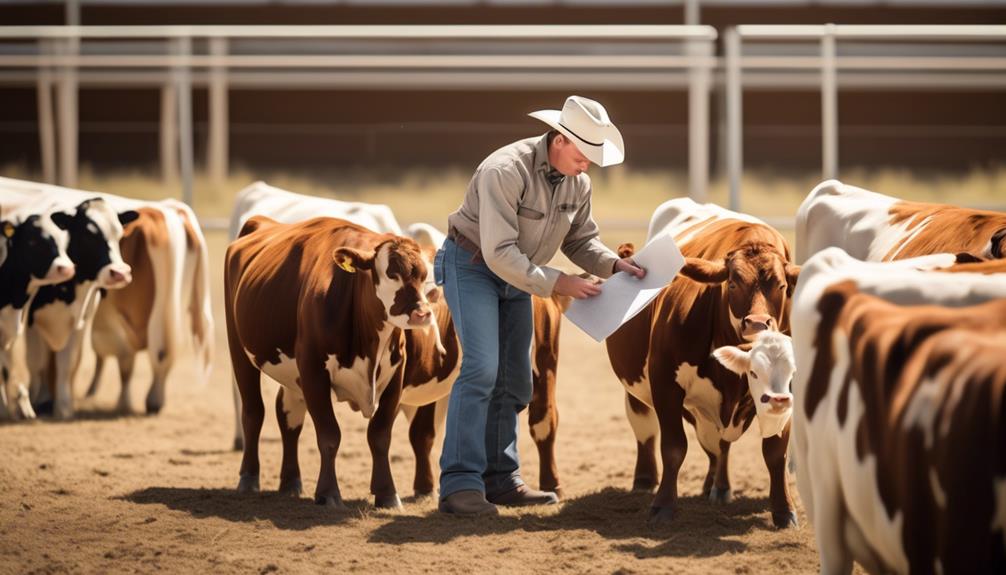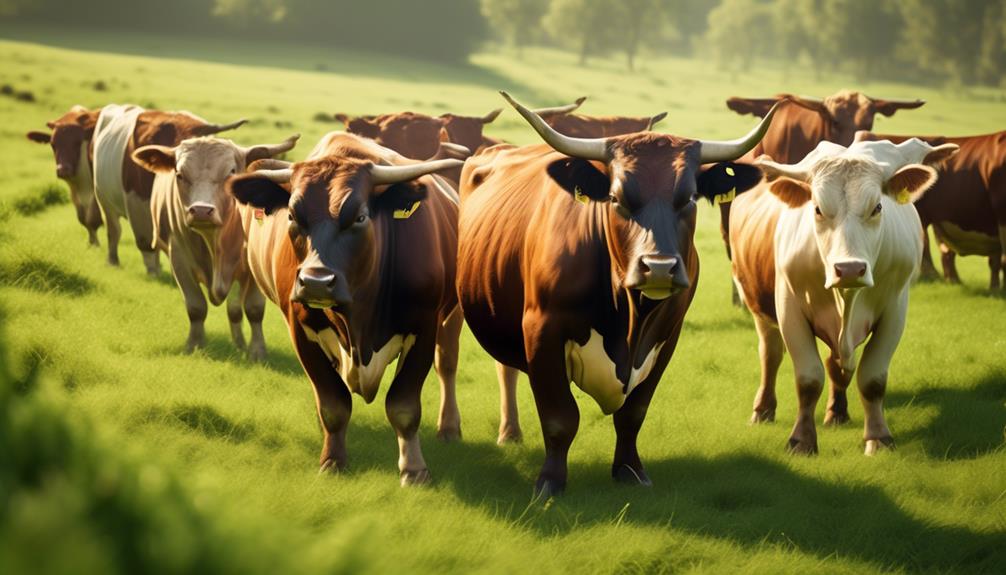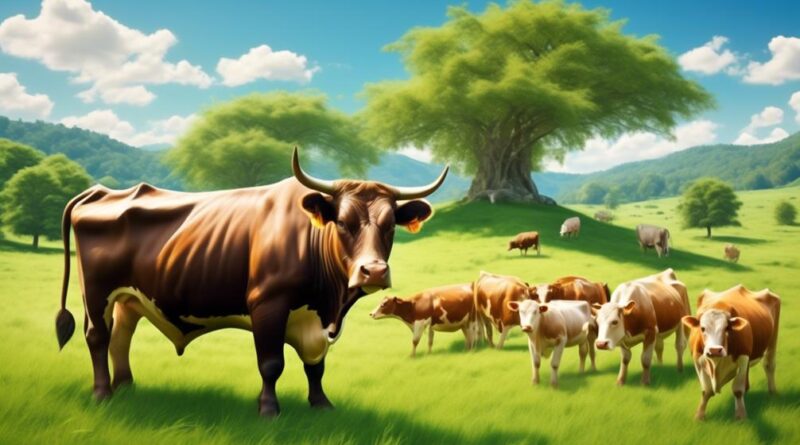Maximizing Cattle Breeding Success: Key Factors Explained
When it comes to cattle breeding, it's like tending a fruitful orchard – the right care and attention can yield a bountiful harvest, while neglect can leave you with sparse pickings.
You might be wondering what exactly goes into maximizing cattle breeding success. Well, there are several key factors that play a crucial role in the process.
From genetic selection to reproductive health, each aspect contributes to the overall success of your breeding program. Understanding these factors and how they interplay is essential for any cattle breeder looking to optimize their operations.
Genetic Selection

When breeding cattle for success, genetic selection is crucial for ensuring desirable traits are passed down to future generations. Genetic transfer plays a key role in herd improvement, as it determines which traits are inherited by offspring. By carefully selecting superior bulls and cows with desired characteristics such as disease resistance, fertility, and high-quality meat production, you can significantly enhance the overall genetic potential of your herd.
To achieve herd improvement through genetic selection, it's essential to identify the specific traits that are most important for your breeding goals. This involves analyzing the strengths and weaknesses of individual animals and using this information to make informed decisions about which cattle to breed. By focusing on traits that align with your breeding objectives, you can gradually enhance the genetic profile of your herd and move closer to your desired outcomes.
Genetic selection also requires a long-term perspective. It's not just about the current generation of cattle, but rather about shaping the genetic makeup of future generations. By consistently choosing breeding stock based on their genetic merit, you can make steady progress towards developing a more productive and resilient herd.
Reproductive Health
Improving reproductive health in your cattle requires proactive management and regular monitoring to ensure optimal breeding conditions. Reproductive hormones play a crucial role in the fertility of your herd. It's essential to monitor these hormones to ensure that your cattle are in the best reproductive health.
Regular fertility monitoring allows you to track the reproductive status of each animal, identify any potential issues early on, and take proactive measures to address them.
When it comes to reproductive hormones, key players include estrogen, progesterone, and testosterone. These hormones regulate the estrous cycle and are essential for successful breeding. By monitoring the levels of these hormones, you can gain valuable insights into the reproductive health of your cattle. This information can help you determine the best time for breeding and identify any hormonal imbalances that may affect fertility.
Fertility monitoring involves keeping detailed records of each animal's reproductive history, including estrus cycles, mating outcomes, and pregnancy rates. By maintaining comprehensive fertility records, you can identify trends, pinpoint any fertility issues, and make informed decisions to improve breeding success.
Additionally, regular veterinary check-ups and reproductive assessments can provide further insights into the overall reproductive health of your herd.
Incorporating reproductive hormone monitoring and fertility tracking into your cattle management practices can significantly enhance breeding success. By staying proactive and vigilant in monitoring and managing reproductive health, you can optimize the fertility of your herd and maximize breeding success.
Nutrition and Feeding

To optimize cattle breeding success, ensure that you provide a balanced and nutritious diet for your herd. Feed quality plays a crucial role in the reproductive performance of your cattle. Make sure to provide a well-balanced diet that meets the nutritional needs of your herd. High-quality forage, such as fresh grass and legumes, should form the basis of their diet. Additionally, consider incorporating dietary supplements to address any nutritional gaps and ensure that your cattle receive all the essential vitamins and minerals necessary for reproductive health.
When it comes to feed quality, aim for a diet that's rich in protein, energy, vitamins, and minerals. Poor feed quality can lead to nutrient deficiencies, which can negatively impact the reproductive capabilities of your cattle. Conduct regular assessments of your feed quality to ensure that it meets the required nutritional standards. Additionally, consider consulting with a nutritionist to formulate a diet that's tailored to the specific needs of your herd.
Incorporating dietary supplements can further enhance the nutritional content of your cattle's diet. These supplements can help address any deficiencies that may exist in the feed, thereby supporting optimal reproductive health. However, it's important to carefully select and administer dietary supplements, taking into account the specific requirements of your herd. Work with a veterinarian or nutritionist to determine the most suitable supplements for your cattle and ensure that they're provided in appropriate quantities.
Breeding Management
Optimizing your cattle's breeding success entails effective breeding management practices to capitalize on their nutritional well-being and reproductive potential. Breeding season plays a crucial role in the reproductive performance of your cattle. Managing the breeding season involves carefully planning and scheduling mating to ensure optimal conception rates and successful calving. It's essential to consider factors such as the age and condition of the cattle, as well as environmental factors like temperature and daylight hours, to determine the most suitable breeding season for your herd.
Reproductive performance monitoring is another critical aspect of breeding management. Regularly assessing the reproductive health and performance of your cattle allows you to identify any issues early on and take necessary actions to address them. This includes monitoring heat cycles, conducting fertility tests, and keeping detailed records of breeding outcomes. By closely tracking reproductive performance, you can make informed decisions regarding breeding strategies and interventions, ultimately maximizing the success of your cattle's breeding endeavors.
Implementing efficient breeding management practices can significantly impact the overall productivity and profitability of your cattle operation. By strategically managing the breeding season and closely monitoring reproductive performance, you can enhance the reproductive efficiency of your herd, leading to improved calf crops and better overall herd health.
Environmental Factors

How do environmental factors influence the breeding success of your cattle?
Environmental factors play a crucial role in determining the breeding success of your cattle. Understanding and managing these factors can significantly impact the health and reproductive success of your herd. Here are some key points to consider:
- Climate Adaptation
Cattle breeds vary in their ability to adapt to different climates. Selecting breeds that are well-suited to your specific environmental conditions can enhance breeding success. For example, certain breeds are better adapted to hot and arid climates, while others thrive in colder environments. Understanding your local climate and choosing breeds that are well-adapted can improve overall breeding outcomes.
- Grazing Patterns
The availability and quality of grazing land directly impact the nutritional intake of your cattle. Proper grazing management, including rotational grazing and monitoring pasture health, can ensure that your cattle have access to the necessary nutrients for optimal breeding performance. Understanding the grazing patterns on your land and implementing sustainable grazing practices can positively influence the reproductive efficiency of your herd.
- Shelter and Protection
Providing adequate shelter and protection from extreme weather conditions is essential for maintaining the health and well-being of your cattle. Extreme heat or cold can negatively impact breeding success, so ensuring that your cattle have access to shelter and protection from harsh environmental elements is crucial for maximizing breeding outcomes.
Understanding and effectively managing these environmental factors can contribute to the overall success of your cattle breeding operation.
Bull Selection and Management
Understanding the impact of environmental factors on your cattle's breeding success can guide your decisions in selecting and managing bulls for optimal reproductive performance.
When it comes to bull selection and management, prioritizing bull fertility and breeding soundness is crucial for successful breeding programs. Bull fertility is essential for achieving high conception rates and ensuring the overall reproductive success of your herd.
It's imperative to assess the breeding soundness of bulls before incorporating them into your breeding program. Conducting thorough breeding soundness evaluations, including physical examinations and semen analysis, can help identify any potential reproductive issues and ensure that only reproductively fit bulls are used for breeding.
Additionally, proper bull management plays a significant role in maximizing breeding success. Providing a suitable environment for bulls, including adequate nutrition and housing, is essential for maintaining their reproductive health and performance.
Regular health monitoring and veterinary care are also critical aspects of bull management to address any potential reproductive challenges promptly.
Timing of Breeding

To maximize breeding success, consider the timing of breeding in relation to the reproductive cycle of your cattle. Understanding the estrus cycle, or heat period, of your cows is crucial for successful breeding. Here are some key points to consider:
- Estrus Detection
- Implement reliable estrus detection methods such as tail paint, chin ball markers, or activity monitoring systems. These tools can help you identify when your cows are in heat, allowing for timely breeding.
- Train your staff to recognize behavioral and physical signs of estrus, such as increased vocalization, mounting other cows, and clear mucus discharge. This can aid in accurate estrus detection without solely relying on technology.
- Breeding Season
- Align the breeding season with the natural reproductive patterns of your cattle to optimize conception rates. Understanding the specific breeding season for your herd, based on factors like climate and nutrition, is essential for successful mating.
- Plan the timing of breeding to coincide with the peak of the cows' reproductive cycle. This can enhance the chances of successful fertilization and pregnancy.
Record Keeping
Keep detailed records of breeding dates, cow identification, and reproductive history for effective management of your cattle breeding program. Proper record-keeping is crucial for successful cattle breeding. It allows you to track the reproductive performance of your herd and make informed decisions to maximize breeding success. Data organization is key to efficient record-keeping. Categorize and store information in a systematic manner, such as using software or spreadsheets, to easily access and analyze the data when needed.
Technology integration plays a vital role in modern record-keeping practices. Utilize digital tools and software designed for cattle management to streamline the process. There are various applications available that can help you record breeding dates, track cow health, and manage genetic information. These tools not only make record-keeping more efficient but also provide valuable insights for making well-informed breeding decisions.
With proper record-keeping and data organization, you can identify patterns in reproductive history, detect any issues early on, and improve the overall breeding outcomes of your cattle. By integrating technology into your record-keeping practices, you can simplify the process and ensure that your breeding program is based on accurate and up-to-date information.
Effective record-keeping isn't just about documentation; it's about using the data to drive informed strategies for maximizing your cattle breeding success.
Frequently Asked Questions
How Can I Effectively Manage Cattle Breeding During Extreme Weather Conditions, Such as Drought or Flooding?
To effectively manage cattle breeding during extreme weather conditions like drought or flooding, you should prioritize managing grazing and ensuring a stable water supply. Providing nutritional supplements can also help maintain breeding performance during these challenging times.
What Are the Potential Impacts of Using Artificial Insemination on the Overall Genetic Diversity of My Cattle Herd?
Using artificial insemination can impact genetic diversity in your cattle herd. However, it can also improve breeding success and reproductive health. Proper management and selection of genetics can help maintain genetic diversity while maximizing breeding success.
Can the Use of Growth Hormones or Other Performance-Enhancing Products Affect the Reproductive Health of My Cattle?
Using performance-enhancing products like growth hormones can impact your cattle's reproductive health. Consider environmental factors and genetic diversity in herd dynamics. Also, be aware of potential consequences on breeding from factors like bull retirement age.
What Are the Best Practices for Managing the Social Dynamics Within a Herd to Maximize Breeding Success?
To maximize breeding success, managing hierarchy and social behavior in your herd is crucial. Understanding herd dynamics and implementing breeding management practices will help create an environment that promotes successful breeding outcomes and overall herd well-being.
How Can I Determine the Ideal Age for Retiring a Bull From Breeding, and What Are the Potential Consequences of Keeping a Bull in Service for Too Long?
You should determine the ideal age for retiring a bull from breeding based on its physical condition and fertility. Keeping a bull in service for too long can lead to decreased fertility, increased injury risk, and lower quality offspring.
Conclusion
You've learned about the key factors in maximizing cattle breeding success. By focusing on:
- Genetic selection
- Reproductive health
- Nutrition
- Breeding management
- Environmental factors
- Bull selection and management
- Timing of breeding
- Record keeping
You can improve the overall success of your breeding program.
Keep these factors in mind as you work to optimize the breeding process and ensure the health and productivity of your cattle herd.
Good luck!
